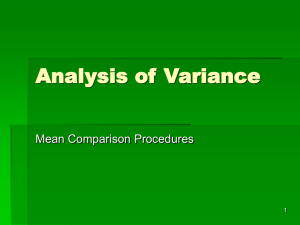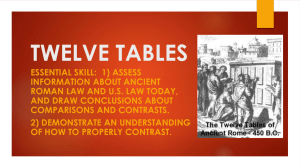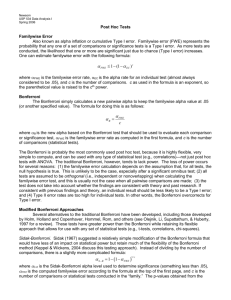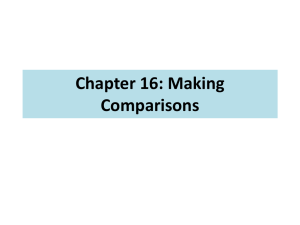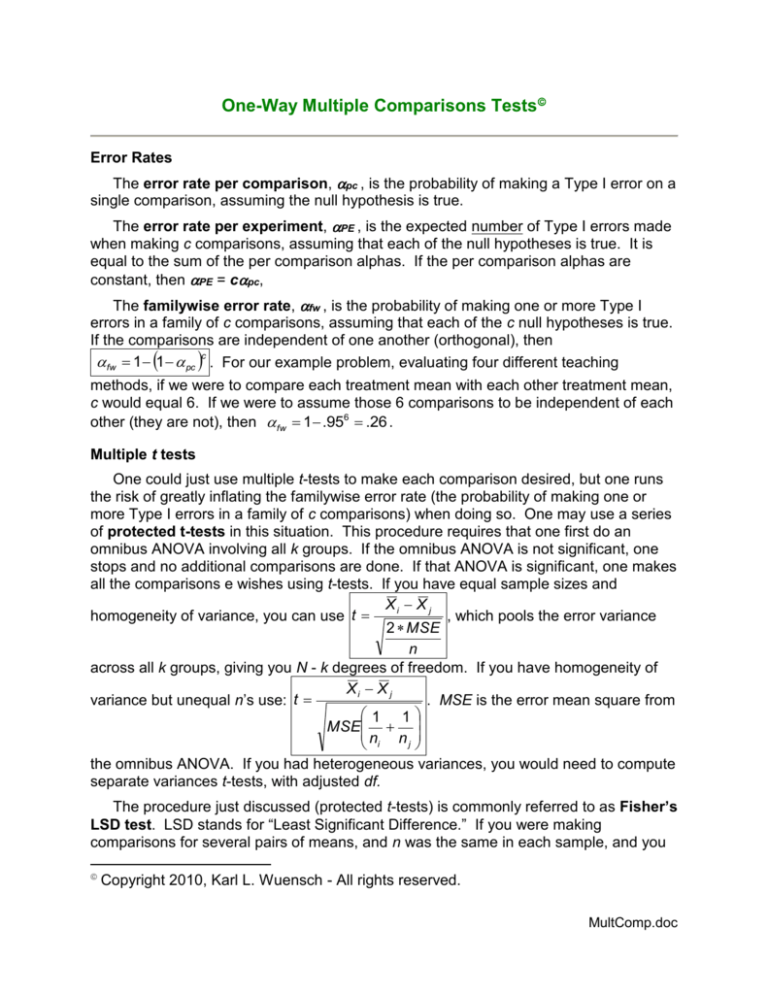
One-Way Multiple Comparisons Tests
Error Rates
The error rate per comparison, pc , is the probability of making a Type I error on a
single comparison, assuming the null hypothesis is true.
The error rate per experiment, PE , is the expected number of Type I errors made
when making c comparisons, assuming that each of the null hypotheses is true. It is
equal to the sum of the per comparison alphas. If the per comparison alphas are
constant, then PE = cpc,
The familywise error rate, fw , is the probability of making one or more Type I
errors in a family of c comparisons, assuming that each of the c null hypotheses is true.
If the comparisons are independent of one another (orthogonal), then
c
fw 1 1 pc . For our example problem, evaluating four different teaching
methods, if we were to compare each treatment mean with each other treatment mean,
c would equal 6. If we were to assume those 6 comparisons to be independent of each
other (they are not), then fw 1 .956 .26 .
Multiple t tests
One could just use multiple t-tests to make each comparison desired, but one runs
the risk of greatly inflating the familywise error rate (the probability of making one or
more Type I errors in a family of c comparisons) when doing so. One may use a series
of protected t-tests in this situation. This procedure requires that one first do an
omnibus ANOVA involving all k groups. If the omnibus ANOVA is not significant, one
stops and no additional comparisons are done. If that ANOVA is significant, one makes
all the comparisons e wishes using t-tests. If you have equal sample sizes and
Xi X j
homogeneity of variance, you can use t
, which pools the error variance
2 MSE
n
across all k groups, giving you N - k degrees of freedom. If you have homogeneity of
Xi X j
variance but unequal n’s use: t
. MSE is the error mean square from
1 1
MSE
n n
j
i
the omnibus ANOVA. If you had heterogeneous variances, you would need to compute
separate variances t-tests, with adjusted df.
The procedure just discussed (protected t-tests) is commonly referred to as Fisher’s
LSD test. LSD stands for “Least Significant Difference.” If you were making
comparisons for several pairs of means, and n was the same in each sample, and you
Copyright 2010, Karl L. Wuensch - All rights reserved.
MultComp.doc
were doing all your work by hand (as opposed to using a computer), you could save
yourself by solving substituting the critical value of t in the formula above, entering the n
and the MSE, and then solving for the (smallest) value of the difference between means
which would be significant (the least significant difference). Then you would not have to
compute a t for each comparison, you would just find the difference between the means
and compare that to the value of the least significant difference.
While this procedure is not recommended in general (it does not adequately control
familywise alpha), there is one special case when it is the best available procedure, and
that case is when k = 3. In that case Fisher’s procedure does hold fw at or below the
stated rate and has more power than other commonly employed procedures. The
interested student is referred to the article “A Controlled, Powerful Multiple-Comparison
Strategy for Several Situations,” by Levin, Serlin, and Seaman (Psychological Bulletin,
1994, 115: 153-159) for details and discussion of how Fisher’s procedure can be
generalized to other 2 df situations.
Linear Contrasts
One may make simple or complex comparisons involving some or all of a set of k
treatment means by using linear contrasts. Suppose I have five means, which I shall
label A, B, C, D, and E. I can choose contrast coefficients to compare any one mean or
subset of these means with any other mean or subset of these means. The sum of the
contrast coefficients must be zero. All of the coefficients applied to the one set of
means must be positive, all those applied to the other set must be negative. Means left
out of the contrast get zero coefficients. There are some advantages of using a
“standard set of weights,” so I shall do so here: The coefficients for the one set must
equal +1 divided by the number of conditions in that set while those for the other set
must equal -1 divided by the number of conditions in that other set. The sum of the
absolute values of the coefficients must be 2.
Suppose I want to contrast combined groups A and B with combined groups C, D,
and E. A nonstandard set of coefficients is 3, 3, 2, 2, 2, and a standard set of
coefficients would be .5, .5, 1/3, 1/3, 1/3. If I wanted to contrast C with combined D
and E , a nonstandard set of coefficients would be 0, 0, -2, 1, 1 and a standard set of
coefficients would be 0, 0, 1, .5, .5.
A standard contrast is computed as ˆ ci Mi .
To test the significance of a contrast, compute a contrast sum of squares this way:
SSˆ
ˆ 2
c 2j
n
j
. When the sample sizes are equal, this simplifies to SSˆ
nˆ 2
. Each
c 2j
contrast will have only one treatment df, so the contrast MS is the same as the contrast
SS. To get an F for the contrast just divide it by an appropriate MSE (usually that which
would be obtained were one to do an omnibus ANOVA on all k treatment groups).
For our example problem, suppose we want to compare combined groups C and D
with combined groups A and B. The A, B, C, D means are 2, 3, 7, 8, and the
2
coefficients are .5, ,5, +.5, +.5. ˆ .5(2) .5(3) .5(7) .5(8) 5 . Note that the
value of the contrast is quite simply the difference between the mean of combined
groups C and D (7.5) and the mean of combined groups A and B (2.5).
5(5)2
5(25)
MSˆ
125 , and F(1, 16) = 125/.5 = 250, p << .01.
.25 .25 .25 .25
1
To construct a confidence interval about ˆ , simply go out in each direction t crit sˆ .,
c 2j
MSE
where sˆ MSE
. With equal sample sizes, this simplifies to sˆ
.
n
nj
When one is constructing multiple confidence intervals, one can use Bonferroni to
adjust the per contrast alpha. Such intervals have been called simultaneous or joint
.5
confidence intervals. For the contrast above, sˆ
.3162 . With no adjustment of
5
the per-comparison alpha, and df = 16, a 95% confidence interval is 5 2.12(.3162),
which extends from 4.33 to 5.67.
A population standardized contrast, , can be estimated by ˆ s ,
where s is the standard deviation of just one of the groups being compared (Glass’ ),
the pooled standard deviation of the two groups being compared (Hedges’ g), or the
pooled standard deviation of all of the groups (the square root of the MSE). For the
contrast above, gˆ 5 .5 7.07 , a whopper effect.
SAS and other statistical software can be used to obtain the F for a specified
contrast. Having obtained a contrast F from your computer program, you can compute
c 2j
.25 .25 .25 .25
gˆ F
. For our contrast, gˆ 250
7.07 .
nj
5
An approximate confidence interval for a standardized contrast d can be
computed simply by taking the confidence interval for the contrast and dividing its
endpoints by the pooled standard deviation (square root of MSE). In this case the
confidence interval amounts to gˆ tcrit sgˆ , where sgˆ
c 2j
n . For our contrast,
j
.25 .25 .25 .25
sgˆ
.2 and a 95% confidence interval is 7.07 2.12(.447),
5
running from 6.12 to 8.02. More simply, we take the unstandardized confidence
interval, which runs from 4.33 to 5.67, and divide each end by the standard deviation
(.707) and obtain 6.12 to 8.02.
At http://www.psy.unsw.edu.au/research/PSY.htm one can obtain PSY: A
Program for Contrast Analysis, by Kevin Bird, Dusan Hadzi-Pavlovic, and Andrew
Isaac. This program computes unstandardized and approximate standardized
confidence intervals for contrasts with between-subjects and/or within/subjects factors.
It will also compute simultaneous confidence intervals. Contrast coefficients are
3
provided as integers, and the program converts them to standard weights. For an
example of the use of the PSY program, see my document PSY: A Program for
Contrast Analysis.
An exact confidence interval for a standardized contrast involving
independent samples can be computed with my SAS program Conf_IntervalContrast.sas. Enter the contrast t (the square root of the contrast F, 15.81 for our
contrast), the df (16), the sample sizes (5, 5, 5, 5), and the standard contrast
coefficients (.5, .5, .5, .5) and run the program. You obtain a confidence interval that
extends from 4.48 to 9.64. Notice that this confidence interval is considerably wider
than that obtained by the earlier approximation.
One can also use 2 or partial 2 as a measure of the strength of a contrast,
and use my program Conf-Interval-R2-Regr.sas to construct a CI. For 2 simply take
the SScontrast and divide by the SSTotal. For our contrast, that yields 2 = 125/138 =
.9058. To get the confidence interval for 2 we need to compute a modified contrast F,
adding to the error term all variance not included in the contrast and all degrees of
freedom not included in the contrast.
Source
SS
df
MS
F
Teaching Method
130
3
43.33 86.66
AB vs. CD
125
1
125 250
Error
8+5=13
16+2=18
Total
138
19
13/18=.722 173.077
SScontrast
125
125
173.077 .
(SSTotal SScontrast ) (dfTotal dfcontrast ) (138 125) (19 1) 13 / 18
Feed that F and df to my SAS program and you obtain an 2 of .9058 with a
confidence interval that extends from .78 to .94.
F (1, 18)
Alternatively, one can compute a partial 2 as
SSContrast
125
.93985 . Notice that this excludes from the denominator
SSContrast SSError 125 8
all variance that is explained by differences among the groups that are not captured by
the tested contrast.
Source
SS
df
MS
F
Teaching Method
130
3
43.33 86.66
AB vs. CD
125
1
125 250
Error
8
16
Total
138
19
0.50
For partial 2 enter the contrast F(1, 16) = 250 into my program and you obtain
2 = .93985 with a confidence interval extending from .85 to .96.
4
Orthogonal Contrasts
One can construct k - 1 orthogonal (independent) contrasts involving k means. If I
consider ai to represent the contrast coefficients applied for one contrast and bj those
a j bj
0 . If you
for another, for the contrasts to be orthogonal it must be true that
nj
a b
0 . Consider the following set of
contrast coefficients involving groups A, B, C, D, and E and equal sample sizes.
have equal sample sizes, this simplifies to
i
j
A
B
C
D
E
+.5
+.5
1/3
1/3
1/3
+1
1
0
0
0
0
0
1
.5
.5
0
0
0
+1
1
If we computed a SS for each of these contrasts and summed those SS, the sum
would equal the treatment SS which would be obtained in an omnibus ANOVA on the k
groups. This is beautiful, but not necessarily practical. The comparisons you make
should be meaningful, whether or not they form an orthogonal set.
Studentized Range Procedures
There is a number of procedures available to make “a posteriori,” “posthoc,”
“unplanned” multiple comparisons. When one will compare each group mean with each
other group mean, k(k - 1)/2 comparisons, one widely used procedure is the StudentNewman-Keuls procedure. As is generally the case, this procedure adjusts downwards
the “per comparison” alpha to keep the alpha familywise at a specified value. It is a
“layer” technique, adjusting alpha downwards more when comparing extremely different
means than when comparing closer means, thus correcting for the tendency to
capitalize on chance by comparing extreme means, yet making it somewhat easier
(compared to non-layer techniques) to get significance when comparing less extreme
means.
To conduct a Student-Newman-Keuls (SNK) analysis:
a. Put the means in ascending order of magnitude.
b. “r” is the number of means spanned by a given comparison.
c. Start with the most extreme means (the lowest vs. the highest), where r = k.
d. Compute q with this formula: q
Xi X j
, assuming equal sample sizes and
MSE
n
homogeneity of variance. MSE is the error mean square from an overall ANOVA on the
k groups. Do note that the SNK, and multiple comparison tests in general, were
5
developed as an alternative to the omnibus ANOVA. One is not required to do the
ANOVA first, and if one does do the ANOVA first it does not need to be significant for
one to do the SNK or most other multiple comparison procedures.
e. If the computed q equals or exceeds the tabled critical value for the studentized
range statistic, qr,df, the two means compared are significantly different, you move to the
step g. The df is the df for MSE.
f. If q was not significant, stop and, if you have done an omnibus ANOVA and it
was significant, conclude that only the extreme means differ from one another.
g. If the q on the outermost layer is significant, next test the two pairs of means
spanning (k - 1) means. Note that r, and, thus the critical value of q, has decreased.
From this point on, underline all pairs not significantly different from one another, and
do not test any other pairs whose means are both underlined by the same line.
h. If there remain any pairs to test, move down to the next layer, etc. etc.
i. Any means not underlined by the same line are significantly different from one
another.
For our sample problem. which was presented in the previous handout, “One-Way
Independent Samples Analysis of Variance,” with alpha at .01:
1.
Group
A
B
C
D
Mean
2
3
7
8
2. n = 5
Denominato r =
.5
0.316
5
3. A vs D: r = 4, df = 16, q
82
18.99 , critical value .01 = 5.19, p < .01
.316
4. r = 3, q.01 = 4.79
a.
A vs C: q
72
15.82 , p < .01
.316
b.
B vs D: q
83
15.82 , p < .01
.316
5. r = 2, q.01 = 4.13
a.
A vs B: q
32
3.16 , p > .01
.316
b.
B vs C: q
73
12.66 , p < .01
.316
6
c.
C vs D: q
87
3.16 , p > .01
.316
6.
Group
A
B
C
D
Mean
2
3
7
8
What if there are unequal sample sizes? One solution is to use the harmonic
~ k . Another solution
mean sample size computed across all k groups. That is, n
1
n
j
is to compute for each comparison made the harmonic mean sample size of the two
2
~
groups involved in that comparison, that is, n
. With the first solution the
1
1
ni n j
effect of n (bigger n, more power) is spread out across groups. With the latter solution
comparisons involving groups with larger sample sizes will have more power than those
with smaller sample sizes.
If you have disparate variances, you should compute a q that is very similar to the
Xi X j
2 t 2 ,
separate variances t-test earlier studied. The formula is: q
2
2
S
Si
j
ni
nj
where t is the familiar separate variances t-test. This procedure is known as the
Games and Howell procedure.
When using this unpooled variances q one should also adjust the degrees of
freedom downwards exactly as done with Satterthwaite’s solution previously discussed.
Consult our text book for details on how the SNK can have a familywise alpha that is
greatly inflated if the omnibus null hypothesis is only party true.
Relationship Between q And Other Test Statistics
The studentized range statistic is closely related to t and to F. If one computes the
pooled-across-k -groups t, as done with Fisher’s LSD, then q t 2 . If one computes
an F from a “planned comparison,” then q 2 F . For example, for the A vs C
72
5
comparison with our sample problem: t
11.18.
2(.5) .447
5
q 15.82 11.18 2 .
7
The contrast coefficients to compare A with C would be .5, 0, .5, 0.
n a j M j
5( .5 2 0 3 .5 7 0 8)2 5(6.25)
62.5 .
The contrast SS
(.25 0 0 .25)
.5
a2j
2
F
62.5
,
5
q 2 125 15.82 .
Tukey’s (a) Honestly Significant Difference Test
This test is applied in exactly the same way that the Student-Newman-Keuls is, with
the exception that r is set at k for all comparisons. This test is more conservative (less
powerful) than the Student-Newman-Keuls.
Tukey’s (b) Wholly Significant Difference Test
This test is a compromise between the Tukey (a) and the Newman-Keuls. For each
comparison, the critical q is set at the mean of the critical q were a Tukey (a) being
done and the critical q were a Newman-Keuls being done.
Ryan’s Procedure (REGWQ)
This procedure, the Ryan / Einot and Gabriel / Welsch procedure, is based on the q
statistic, but adjusts the per comparison alpha in such a way (Howell provides details in
our text book) that the familywise error rate is maintained at the specified value (unlike
with the SNK) but power will be greater than with the Tukey(a). I recommend its use
with four or more groups. With three groups the REGWQ is identical to the SNK, and,
as you know, I recommend Fisher’s procedure when you have three groups. With four
or more groups I recommend the REGWQ, but you can’t do it by hand, you need a
computer (SAS and SPSS will do it).
Other Procedures
Dunn’s Test (The Bonferroni t )
Since the familywise error rate is always less than or equal to the error rate per
experiment, fw c pc , an inequality known as the Bonferroni inequality, one can be
sure that alpha familywise does not exceed some desired maximum value by using an
adjusted alpha per comparison that equals the desired maximum alpha familywise
divided by c, that is, pc
fw
. In other words, you compute a t or an F for each
c
desired comparison, usually using an error term pooled across all k groups, obtain an
exact p from the test statistic, and then compare that p to the adjusted alpha per
comparison. Alternatively, you could multiply the p by c and compare the resulting
“ensemble-adjusted p” to the maximum acceptable familywise error rate. Dunn has
provided special tables which give critical values of t for adjusted per comparison
alphas, in case you cannot obtain the exact p for a comparison. For example, t120 =
2.60, alpha familywise = .05, c = 6. Is this t significant? You might have trouble finding
a critical value for t at per comparison alpha = .05/6 in a standard t table.
8
Dunn-Sidak Test
Sidak has demonstrated that the familywise error rate for c nonorthogonal
(nonindependent) comparisons is less than or equal to the familywise error rate for c
orthogonal comparisons, that is,
fw 1 1 pc . Thus, one can adjust the per comparison alpha by using an
c
adjusted criterion for rejecting the null: Reject the null only if p 1 1 fw . This
procedure, the Dunn-Sidak test, is more powerful than the Dunn test, especially when c
is large.
1/ c
Scheffé Test
To conduct this test one first obtains F-ratios testing the desired comparisons. The
critical value of the F is then adjusted (upwards). The adjusted critical F equals (the
critical value for the treatment effect from the omnibus ANOVA) times (the treatment
degrees of freedom from the omnibus ANOVA). This test is extremely conservative
(low power) and is not generally recommended for making pairwise comparisons. It
assumes that you will make all possible linear contrasts, not just simple pairwise
comparisons. It is considered appropriate for making complex comparisons (such as
groups A and B versus C, D, & E; A, B, & C vs D & E; etc., etc.).
Dunnett’s Test
The Dunnett t is computed exactly as is the Dunn t, but a different table of critical
values is employed. It is employed when the only comparisons being made are each
treatment group with one control group. It is somewhat more powerful than the Dunn
test for such an application.
Presenting the Results of Pairwise Contrasts
I recommend using a table like that below. You should also give a brief description
of the pattern of significant differences between means, but do not mention each
contrast that was made in a large set of pairwise contrasts.
“Teaching method significantly affected test scores, F(3, 16) = 86.66, MSE = 0.50, p
< .001, η2 = .94, 95% CI [.82, .94].” Pairwise comparisons were made with Tukey’s
HSD procedure, holding familywise error at a maximum of .01. As shown in Table 1,
the computer intensive and discussion centered methods were associated with
significantly better student performance than that shown by students taught with the
actuarial and book only methods. All other comparisons fell short of statistical
significance.
Table 1
Mean Quiz Performance By Students Taught With Different Methods
Method of Instruction
Actuarial
Book Only
Computer Intensive
Discussion Centered
Mean
2.00A
3.00A
7.00B
8.00B
9
Note. Means sharing a letter in their superscript are not
significantly different at the .01 level according to a Tukey
HSD test.
Familywise Error, Alpha-Adjustment, and the Boogey Men
One should keep in mind that the procedures discussed above can very greatly
lower power. Unless one can justify taking a much greater risk of a Type II error as the
price to pay for keeping the conditional probability of a Type I error unreasonably low, I
think it not good practice to employ these techniques. So why do I teach them? Well,
because others will expect you (and me) to use these techniques even if we think them
unwise. Please read my rant about this: Familywise Alpha and the Boogey Men.
Can I Make These Comparisons Even If The ANOVA Is Not Significant?
Yes, with the exception of Fisher’s procedure. The other procedures were
developed to be used instead of ANOVA, not following a significant ANOVA. You don’t
even need to do the ANOVA, and if you do, it does not need to be significant to be
permitted to make multiple comparisons. There is much misunderstanding about this.
Please read Pairwise Comparisons.
fMRI Gets Slap in the Face with a Dead Fish – an example of research where so many
comparisons are made that spurious effects are very likely to be found.
Return to Karl’s Stats Lessons Page
Copyright 2010, Karl L. Wuensch - All rights reserved.
10


